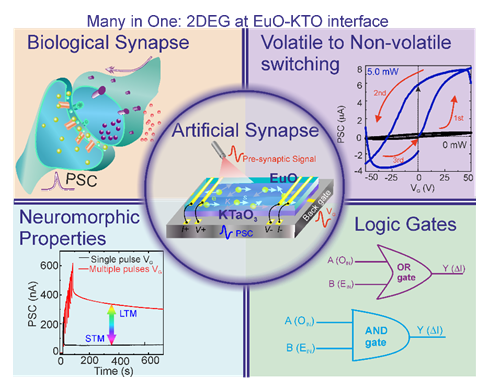New artificial synaptic chip mimicking biological synapses to transform information technology
Scientists have created an artificial synaptic device that emulates the behaviour of biological synapses to transform information technology through more efficient computing models.
They have used two-dimensional electron gas in oxide heterostructures for integrating architecture inspired by the biological brain, also called neuromorphic architecture and logic operations on a single chip.
Modern computers inherently segregate memory and computation into independent physical units based on ’von Neumann computing’– a system which is like a set of instructions that tells the computer how to handle information and perform tasks. This requires separate units for reading and executing complex operations, and then returning the results to memory, which slows computing. This can create a “bottleneck,”. Especially if the computer needs to handle a lot of instructions and data at the same time, it can get slowed down because everything has to travel along the same path.
On the other hand, a human brain is a sophisticated, dynamic, reconfigurable system with direct memory access, with neurons conducting the computational operations. Neuromorphic electronics, inspired by the intricate workings of the biological brain, offer the potential to transform information technology through more efficient computing models.
Scientists at the Institute of Nano Science and Technology (INST), Mohali (Punjab), an autonomous institution of the Department of Science and Technology (DST), Government of India used a new approach that follows the working principal of human brains to overcome the challenges of ’von Neumann computing’.
They utilized the two-dimensional electron gas (2DEG) within the EuO-KTaO3 (KTO) oxide heterostructure to develop a chip which exhibited neuromorphic properties as well as showed a large change in resistivity known as resistive switching behaviour.
Current is generated at EuO-KTaO3 interface due to shining of light and this persists even after the light is turned off (demonstrating high persistent photoconductivity) resulting in optoelectronic properties necessary for replicating cognitive functions such as sensory perception, learning, and memory.
The developed chip not only mimics the short- and long-term plasticity observed in biological synapses but also performs logic gate operations, significantly enhancing its versatility and potential for integration in advanced neuromorphic systems.
Supported by the DST’s Nanomission, and CSIRin the form of a sophisticated, custom-made instrument called a combinatorial pulsed laser deposition setup, Prof. Suvankar Chakraverty Professor at INST, Mohali (Punjab), haveproduced 2DEG at the interface composed of chemicals EuO and KTaO3acting as artificial synaptic device showing neuromorphic properties.The researchwas published in the journal ‘Applied Physics Letter’.
Neuromorphic design in oxide interfaces can facilitate more energy-efficient and quicker information processing, enhanced AI capabilities, and improved device miniaturisation. These systems may learn and change with time, resulting in more personalized and responsive technology. Furthermore, their resilience and fault tolerance make them perfect for important applications that will ultimately improve everyday life, including healthcare, education, and environmental sustainability.

